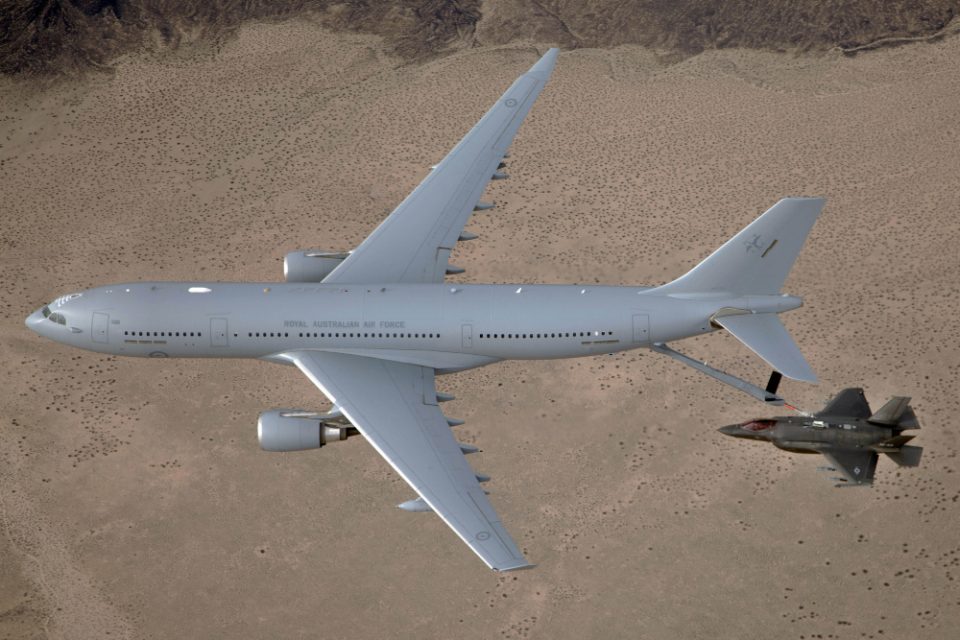2016-03-04 Given the capabilities of the KC-30A in terms of fuel loads, reach and range (including its own capability to be refueled) and the reach of a fleet of F-35s in terms of their interactive capabilities, the combination will be a powerful one.
We are visiting Edwards AFB next week and have a chance to look at both air systems and discuss with the participants the emergence of this new 21st century air combat capability.
Last Fall, saw the two planes fly together for the first time.
The refuelling boom of a Royal Australian Air Force KC-30A Multi-Role Tanker Transport makes contact with the receptacle of a United States Air Force F-35A Joint Strike Fighter flies during boom refuelling trials in the United States.
The F-35A is equipped with symmetrical external stores for this trial.
A total of 59 contacts were conducted of which five contacts transferred 43,200 pounds of fuel during the four hour sortie.
Operating from Edwards Air Force Base in the California desert, the RAAF KC-30A flew 12 sorties with a United States Air Force F-35A from 23 September to 26 October.
Using the 18-meter-long Advanced Refuelling Boom System (ARBS) mounted on the tail of the KC-30A, the RAAF crew made a total of 479 ‘dry’ and 24 ‘wet’ contacts with the refuelling receptacle on the F-35A, and transferred more than 95 tonnes of fuel.
KC-30A Transition and Receiver Clearance Manager Wing Commander Grant Kelly said the trials would allow RAAF and foreign F-35As alike to be refuelled.
“These trials are another important step in building KC-30A capability and the results will inform the training practices of current and future RAAF personnel on both aircraft types,” WGCDR Kelly said.
“Air-to-air refuelling will be an important ‘force multiplier’ for the F-35A fleet, considerably boosting their range and endurance, or allowing them to carry bigger payloads.”
As well as the ARBS, the KC-30A is also equipped with hose-and-drogue refuelling pods that are compatible with Air Force’s Hornets, Super Hornets and Growlers. A single KC-30A can carry a fuel load of more than 100 tonnes and remain 1800 kilometres from its home base with 50 tonnes of fuel available for offload, for four hours.
“The impact of the KC-30A is already being felt in the Middle East Region, where the ARBS and hose-and-drogue capabilities are enabling RAAF and Coalition aircraft to fly sorties of more than 10 hours,” WGCDR Kelly said.
“After more than a year of deployed KC-30A operations, it has built a reputation as the ‘Coalition tanker of choice’.”
Throughout the trials at Edwards Air Force Base, the KC-30A was operated by personnel from No. 33 Squadron. A flight test team from the RAAF’s Aircraft Research and Development Unit, supported by flight test instrumentation engineers from the Aerospace Systems Engineering Squadron, was integrated within the USAF Test Centre to work on a dynamic test program.
The Royal Australian Air Force (RAAF) has completed the first fuel transfer with the air refuelling boom from a RAAF KC-30A Multi-Role Tanker Transport (MRTT) to a US Air Force (USAF) F-35A Joint Strike Fighter at Edwards Air Force Base in California. A total of 59 contacts were conducted of which five contacts transferred 43,200 pounds of fuel during the four hour sortie.
Chief of the Air Force, Air Marshal Leo Davies AO CSC, described the trial as a significant step in the development of the KC-30A’s capability.
“Our KC-30A is an essential force multiplier. Mid-air refuelling is critical to ensuring global reach for our aircraft, our people and our equipment,” Air Marshal Davies said.
“Refuelling between the KC-30A and F-35A is an important step towards the KC-30A’s achievement of Final Operational Capability (FOC) and represents continued progress in the development of the F‑35A.
“This achievement is significant because the future of Australia’s air combat capability is reliant on the successful partnership between these two aircraft and our ability to be interoperable with our international partners,” Air Marshal Davies said.
The KC-30A has two refuelling systems – the hose-and-drogue and Advanced Refuelling Boom System (ARBS). The two different refuelling systems allow RAAF to support a wide range of coalition aircraft on Operation OKRA where a KC-30A is currently deployed to support combat operations against Daesh in Iraq and Syria.
The five KC-30As are based at RAAF Base Amberley (QLD) and Air Force will receive an additional two in 2018. A single KC-30A can carry a fuel load of more than 100 tonnes and remain 1800 kilometres from its home base with 50 tonnes of fuel available for offload, for four hours.
Australia has committed to 72 F-35As for RAAF Bases Williamtown and Tindal, with the first aircraft arriving in late 2018. The F-35A will replace the ageing F/A-18A/B Hornet with a 5th-generation networked fighter aircraft.
9/29/15
Credit: Australian Ministry of Defence


